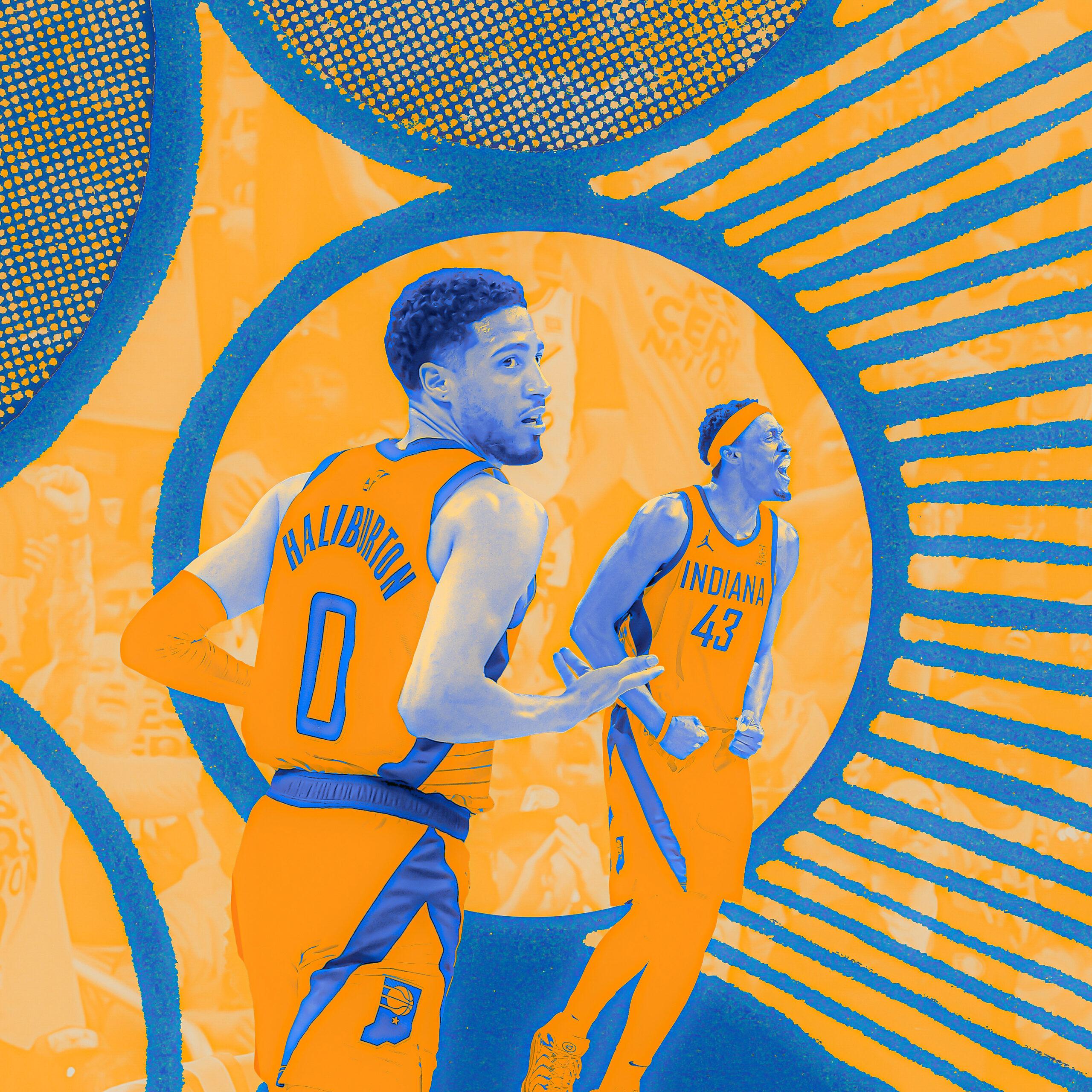
If I ventured in the slipstream
Between the viaducts of your dream
Where immobile steel rims crack
And the ditch in the back roads stop
Could you find me?
—Van Morrison, “Astral Weeks”
There isn’t really any way of overstating it: What Tyrese Haliburton did on Tuesday night in Indianapolis communed with the immortals. In a pivotal Game 4 of the Eastern Conference finals, Haliburton logged 32 points, 12 rebounds, 15 assists, five 3-pointers, four steals, and zero turnovers in a 130-121 win over the New York Knicks. One of the greatest performances from an NBA point guard, ever. And it’s brought the Indiana Pacers to a 3-1 series lead, just one win away from the franchise’s first NBA Finals appearance in 25 years.
It was the type of game that not only cemented Haliburton as a bona fide superstar but also may well inspire the next generation of point guards to embrace the quirks in their own style of play. For years, Haliburton has pushed against the insularity of basketball’s collective aesthetic bias. His economy of motion is bewildering. His dribble is slippery. His shot mechanics are perfectly hideous. There is almost a cartoonish, slapstick quality to his game that feels out of time but also uniquely suited to representing basketball today. He prances around like Martin Prince but shoots like Bobby Hill. And it’s fucking amazing. You know what’s overrated? Being cool is overrated. I’ll hear from the boss if I’m overstepping here, but I’m ready to call it: All hail the new Dork Elvis.
The freewheeling habitus inherent to Haliburton’s style belies the precision of his game. The lack of turnovers in Game 4 was no fluke: Tuesday night’s master class was Hali’s 11th career game with at least a 15-to-0 assist-to-turnover ratio, according to Sportradar’s Todd Whitehead. Only John Stockton (14) and Chris Paul (13) have more such games. Haliburton may well lap the field several times over by the end of his career; he’s only 25. The game whirrs around him, and the Pacers stir up frenzy only to cocoon themselves within it. But chaos can be harnessed. Great point guards create an overarching sense of beauty and order in the game. And within that framework is a new logic, imminently translatable across the rest of the team. It widens the scope of possibility, magnifies what a teammate believes himself capable of achieving. It can embolden an otherwise tunnel-visioned decision-maker like Bennedict Mathurin to make the right pass on a drive. It can expand the imagination of a player like Myles Turner, allowing him to be receptive to a pass he knows wouldn’t normally be delivered.
On a 15-assist night, one play stood out as uniquely Hali. Roughly midway through the third quarter, Haliburton bolted into a double-drag screen meant to toss Mikal Bridges in a pinball machine. There was the slightest window for a low-angle pocket pass to a rolling Turner—Haliburton faked the pass, and Turner dipped his torso low accordingly, just in case the ball did head toward him. The fake momentarily froze Karl-Anthony Towns, which created an awkward logjam as Bridges reentered the play—the two Knicks effectively ran into each other trying to stop the ball, leaving Turner unobstructed under the basket. Haliburton jumped in the air and double-clutched for a moment before sending a side-angle lob for an easy layup. Classic Hali. The type of play that inspired the perfect gift for the Haliburton fan in your life: a T-shirt that reads Jump passes are good now.
"My game is a little unorthodox,” Haliburton said after the game. “I jump to pass probably more than anybody in the NBA. But I work on that stuff."
The effect Haliburton has on the Pacers offense is akin to a slipstream, reducing drag and creating a structure that maximizes the efficiency of the players flanking him. And there aren’t many players over the past decade who have benefited from playing within the slipstream of a superstar more than Pascal Siakam, who killed the Knicks softly in Game 4 with an absurdly efficient 30 points. Siakam’s breakout season ran concurrently with Kawhi Leonard’s lone season in Toronto; it’s hard to believe that it’s been nearly six years since Game 1 of the 2019 NBA Finals—wherein Siakam was the best player in a game that featured at least five future Hall of Famers. Six years later, this version of Siakam is the most realized yet. Credit aerodynamics. Credit the synchronicity of strangeness that powers the Pacers’ chaos engine.
Siakam is a perfect stylistic complement to Haliburton—a kindred weirdo who doesn’t have presets, whose unorthodoxy is a purely individual expression of how he intuits the game. Maybe more than any other star in the league, Pascal’s game does not track as a collage of outside influences. On a TNT pregame show earlier in the series, Draymond Green mentioned Siakam as one of his toughest covers—he acknowledged losing his defensive matchup to Siakam handily in those 2019 Finals. Green, one of the greatest defenders of the century, is a super-processor of information, but that relies on endless mental simulations of the most probable outcomes. Siakam, as ever, slip-slides away from such categorizations.
He’s always been known for his spin move, but where it was once overly telegraphed, the move has become more and more dictated by reading the micro-movements of his defender—an organic response to his environment. As soon as you get accustomed to the spin, Siakam is liable to feign the motion only to slip into a behind-the-back dribble to catch you off-balance:
Nothing is premeditated. The game flows when you read and react. Siakam’s sudden emergence as a steady spot-up shooter from deep has unlocked all the frontiers of his versatility, allowing him to truly inhabit the offense as an omni-dimensional presence. It’s a testament to the Pacers’ deep and abiding understanding of Haliburton’s ethos that they doubled down on unorthodoxy with his lead running mate. It’s what makes this team special.
The Pacers are now 11-3 in the postseason and 45-17 since the New Year—a .726 win percentage. They’ve been one of the four best teams in the NBA for a while now. And should things hold across both conference finals series—which mirror each other at 3-1 apiece—then these games of attrition will have gotten things right: The Thunder and Pacers are the two best teams remaining. The Pacers play an outrageously fun, visceral style of up-tempo basketball. They pressure. They drive and kick with almost unilateral focus. They have a coach who is unendingly curious and open to riding the shifting winds of the game. The Pacers are tantalizingly close to the promised land. Their guiding lights may not look like the kinds of stars we’ve grown familiar with, but their difference has been the difference.







